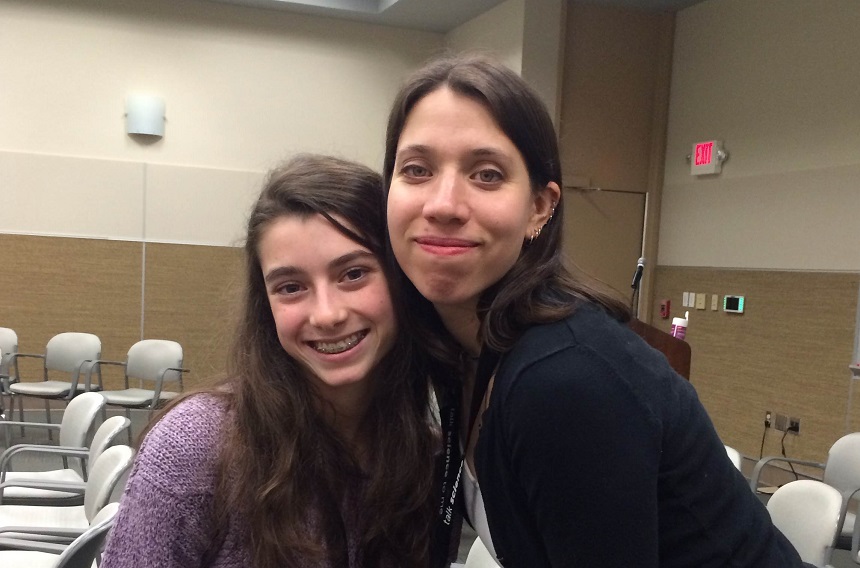Sharing a love of science with the world
Julia Paoli writes a science blog about viruses

Julia Paoli (left) uses a science blog to share the science behind viruses with a wide audience. Here she poses with the author (right) at the 2014 Science Online Together conference.
B. Brookshire/SSP
Some science writers get started in college. Some wait until graduate school or even long after. But Julia Paoli didn’t see a reason to wait. The student at Trinity Preparatory School in Winter Park, Fla., started her science writing career at 15.
“I love that science isn’t biased,” says Julia, now 16. “In English, when you write an essay, it’s subjective. But in science, for the most part it’s right or wrong.” She is the author of a science blog. It’s one of around 8 active high school student blogs on Scitable, a website run by Nature Publishing Group, based in London, England.
Julia’s high school life sciences teacher, Lali DeRosier, had announced in class that Scitable was looking for a high school writer. DeRosier sent Julia the application. The teen learned that getting a spot on a Nature blog site “was a complicated process.” She had to write a sample blog post, describe what topics she would like to cover in a science blog and submit potential images that would make her blog stand out. Ultimately, Julia’s blog — Viruses 101— was approved.
A few years earlier, Julia read The Hot Zone. This book recounted the crisis brought on by a terrifying outbreak of the Ebola virus among monkeys brought to a U.S. research laboratory: “I loved it,” Julia says of the book. “I’ve been interested in viruses ever since.” On her blog, Julia now has the opportunity to explore all the viruses she wants. So far, she’s written about many, including rabies, a virus killing coral reefs and the Human Immunodeficiency Virus (and how viruses in cats can be used to find a vaccine against HIV).
Julia posts about one piece a month. She’s also a dancer and a violinist. So finding time to research and write her science blog takes a balancing act. “I try to narrow the process down to about a week,” she says. After picking a topic, she does a few days of research. She hunts down journal articles and other types of information, and takes lots of notes. After that, Julia spends a few days drafting her blog post. Once she is satisfied with a piece, she sends it to her teacher or her father to look it over and help her edit it.
Julia has important guidelines for her research. “I never use Wikipedia,” she explains. “I like the Centers for Disease Control and Prevention and the World Health Organization websites.” She says she looks at university websites where scientists write about their research. Julia also pores over scientific journal articles and news accounts written by professional science writers until she fully understands her topic.
Her science blog has given Julia a lot of writing practice. It’s also enabled her to communicate with scientists and science writers. “I was writing about a virus that infects wasps,” she recalls. “There was a professor in France who worked with them. I emailed him and he answered back. Usually scientists are really good about getting back to me.”
Julia also recently attended Science Online Together. It’s a meeting for people who communicate about science online through blogs, videos and more. While she was there, she was able to chat with one of her favorite writers, Jennifer Frazer, a award winning science writer. Julia was thrilled to be able to tell Frazer how much she admired her writing, and to receive Frazer’s encouragement in return.
But the best part, she says, is the feedback from readers. “I’ve gotten emails from people across the world!” she notes. “They have questions for me or they say they like my work.” Such comments let her know that her writing is reaching the wider world.
Julia plans to continue writing her blog through high school. It’s a good starting point, as she wants to become a virologist and study her favorite virus: Ebola. “If you’re interested in writing, go for it,” she says. Even a teen, she says, can have an impact through writing “as long as you put in the effort.”
Follow Eureka! Lab on Twitter
Power Words
ebola A family of viruses that cause a deadly disease in people. Most cases occur in Africa and Asia. The viruses causes headaches, fever, muscle pain and extensive bleeding.
HIV (short for Human Immunodeficiency Virus) A potentially deadly virus that attacks cells in the body’s immune system and causes acquired immune deficiency syndrome, or AIDS.
rabies A virus that is transmitted from mammals such as bats, raccoons, skunks and dogs — sometimes to people. Rabies is found on every continent except Antarctica, and is spread by contact with the saliva of an infected host. A vaccine exists. Without a vaccination, nearly every infected person will die.
virologist A researcher who studies viruses and the diseases they cause.
virus Tiny infectious particles consisting of RNA or DNA surrounded by protein. Viruses can reproduce only by injecting their genetic material into the cells of living creatures. Although scientists frequently refer to viruses as live or dead, in fact no virus is truly alive. It doesn’t eat like animals do, or make its own food the way plants do. It must hijack the cellular machinery of a living cell in order to survive.